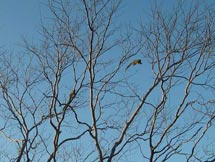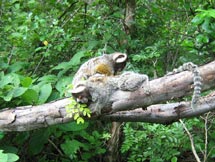
Copyright © H. M. Buchanan-Smith
Marmosets are adept at moving through the forest with infants on their back
View large imageFollow wild common marmosets through their day from waking to sleeping in this video. Natural adaptations of common marmosets are highlighted with suggestions as to how these may be catered for in captivity.
Time is spent gouging for gum and foraging for insects, interspersed with bouts of resting and grooming. A near-constant lookout is maintained to detect potential predators. Twin babies are cared for by all members of the family group. Marmosets are skilled at moving through the branches, both with or without infants on their back. Occasionally the babies leave their carriers’ backs to explore and play.
This footage was taken, with assistance from Ana Karinne, at a long-term field site in Brazil, run by Dr Maria Fátima Arruda and Prof Arrilton Araújo, of the Federal University Rio Norte.

Copyright © H. M. Buchanan-Smith
Marmosets are adept at moving through the forest with infants on their back
View large image
Copyright © H. M. Buchanan-Smith
Marmosets remain alert even at rest.
View large image
Copyright © H. M. Buchanan-Smith
All members of the group take turns to carry the infants
View large image
Copyright © H. M. Buchanan-Smith
Marmosets are weaned later in the wild than they are in captivity
View large image
Copyright © A. Karinne
Marmosets collectively surround an opossum. Piloerection indicates aggression and anxiety, even though it is not a predator
View large image
Copyright © H. M. Buchanan-Smith
Wild marmosets spend time resting and socialising together
View large image
Copyright © H. M. Buchanan-Smith
Marmosets gouge trees to feed on gum. Providing branches and gum is really important in captivity
View large image
Copyright © H. M. Buchanan-Smith
Infants leave their carriers’ backs to explore the environment
View large image
Copyright © H. M. Buchanan-Smith
Infants leave their carriers’ backs to explore the environment
View large image
Copyright © A. Karinne
Infants leave their carriers’ backs to explore the environment
View large image
Copyright © A. Karinne
Marmosets leap over huge distances in the forest
View large image
Copyright © H. M. Buchanan-Smith
Adults keep a careful eye on infants as they explore on their own
View large image
Copyright © H. M. Buchanan-Smith
Even while resting marmosets keep an eye on their surroundings
View large image
Copyright © A. Karinne
Even a slender branch offers support
View large image
Copyright © A. Karinne
Marmosets rest in between bouts of foraging and feeding
View large image
Copyright © H. M. Buchanan-Smith
Marmosets relax and rest a number of times throughout their day
View large image
Copyright © H. M. Buchanan-Smith
All members of the group take turns to carry the infants
View large image
Copyright © H. M. Buchanan-Smith
Calling is vital for keeping track of other group members in the dense forest environment
View large image
Copyright © H. M. Buchanan-Smith
Marmosets cling vertically to tree trunks using their claw-like nails
View large image
Copyright © H. M. Buchanan-Smith
Group members take turns at babysitting the infants
View large image
Copyright © A. Karinne
Social grooming is important for bonding
View large image
Copyright © H. M. Buchanan-Smith
Marmosets cling vertically to tree trunks using their claw-like nails
View large image
Copyright © H. M. Buchanan-Smith
Wild marmosets spend lots of time allogrooming
View large image
Copyright © A. Karinne
Even slender branches offer support
View large image
Copyright © H. M. Buchanan-Smith
Looking after infants in this environment requires strength and agility
View large image
Copyright © A. Karinne
Social grooming is an important social behaviour. Captive marmosets need large flat perches to allow grooming
View large image
Copyright © H. M. Buchanan-Smith
A group of marmosets often feed on the same tree making multiple gouge marks
View large image
Copyright © A. Karinne
Wild marmosets gnaw trees for gum, a source of energy-rich food
View large image
Copyright © H. M. Buchanan-Smith
Wild marmosets feed on flowers and nectar.
View large image
Copyright © H. M. Buchanan-Smith
A marmoset rests in the slob/flop position on a branch.
View large image
Copyright © H. M. Buchanan-Smith
All members of a family group cooperate to raise the young
View large image
Copyright © H. M. Buchanan-Smith
Infants leave their carriers’ backs to explore the environment
View large image
Copyright © A. Karinne
Marmosets can reach fruit by hanging upside down by their feet
View large image
Copyright © H. M. Buchanan-Smith
Marmosets scan their surroundings for predators
View large image
Copyright © A. Karinne
Marmosets cling vertically to tree trunks using their claw-like nails
View large image
Copyright © H. M. Buchanan-Smith
Before disk, a marmoset rests before retiring to sleep in a huddle high in the trees
View large image